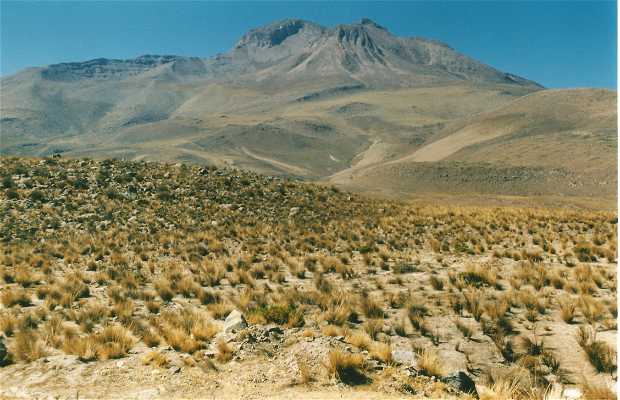E.Sonia Requejo Salces
in the highlands of the plateau.
en las punas del altiplano .
Dejamos Arequipa, comenzamos a través del altiplano a ver un paisaje de planicies, de punas, con alpacas, llamas y vicuñas (fauna altoandina) estas ultimas, protegidas dada su escasez, pastando hasta llegar a Chivay a 160 Km al este de Arequipa .
Paisajes casi lunares, descarnados por la altitud y en pequeños miradores, encontramos a grupos de vendedoras con sus niños, que esperan nuestro paso.
Estas poblaciones elaboran prendas de gran colorido y abrigo, algo imprescindible para vivir a estas alturas, colorido y dibujos que son un verdadero código de señales de identidad y creencias.
El altiplano alberga un gran número de aldeas y pequeños pueblos, viven de la ganadería y de lo que cultivan, conservando muchas tradiciones de la época inca.
Valles fértiles, pero duros de arar con sus primitivas herramientas (taquillajta) con tronco de madera al que le atan una hoja de hierro, que impulsan con el pie para hacer los surcos uno a uno.
Cereales como maíz o sara y quinoa muy nutritivos, aveces se dan cita en los mercados del valle para intercambiar productos con otras comunidades.
Comunidades andinas que viven al pie de las nubes, el medio natural del pueblo quechua, al pertenecen casi la mitad de la población peruana, son indios quechuas. Mantienen las mismas formas de vida de antaño, aldeas construidas en de piedra y techos con aguadas de paja.
Pero el hombre andino realiza ritos a la Pachamama, un diálogo con el amor y el respeto con la naturaleza
Seguimos por el "Valle de los Volcanes" merece la pena visitarlo sin prisa, nos encontraremos con etnias (Cabana y Collagua) esta ultima se la conoce como "Los Hijos del Volcán" ambas con diferencias marcadas tanto en vestimenta, lengua y costumbres.
De camino al Valle del río Colca nos encontramos con algunas señoras y niñas Collaguas, hablaban el aimara y portaban ropa y sombreros muy decorados.
Dejamos tras nuestro encuentro, a gente tímida tal vez, humilde y sencilla de pocas palabras ¡Pero sin duda, son encuentros maravillosos del viaje por las tierras del altiplano peruano!
We leave Arequipa, we started through the altiplano to see a landscape of plains, of punas with alpacas, llamas and vicuas (altoandina fauna) these last, protected because of its scarcity, grazing up to Chivay 160km east of Arequipa. almost lunar landscapes, fleshless by altitude and in small viewpoints, we find groups of vendors with their children, they await our step. These populations produce colorful clothing and shelter, something essential to live at this point, colorful and drawings that are a real code of signals of identity and beliefs. The plateau is home to a large number of villages and small towns, live cattle and what they grow, preserving many traditions of the Inca little. Fertile valleys, but hard to plow with their primitive tools (taquillajta) with wooden trunk that bind an iron sheet, driving with your foot to make the rows one by one. Sara grains such as corn or quinoa and very nutritious, sometimes gathered in the valley markets are given to exchange products with other communities. Andean communities living at the foot of the clouds, the natural environment of the Quechua people, to belong almost half of Peru's population are Quechua Indians. Maintain the same lifestyles of antao, villages built in stone and thatched roofs watered down. But the Andean man performs rites to the Pachamama, a dialogue with the love and respect with nature We follow the "Valley of the Volcanoes" worth a visit without hurry, we will find Ethnicities (Cabana and Collagua) the latter is the known as "children of the Volcano" both with marked differences in dress, language and customs. On the way to the river Colca Valley we met some ladies and girls Collaguas spoke Aymara and wore clothes and highly decorated hats. We left after our encounter, perhaps timid, humble and simple people of few words but certainly are wonderful encounters journey through the lands of the Peruvian highlands!



+14

